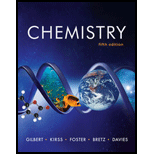
Concept explainers
(a)
Interpretation: The unit cells present in a cubic silver particle with an edge length of
Concept introduction: Silver crystallizes in a fcc crystal arrangement. This crystal structure has 8 atoms at each corner of the cube and 6 atoms at each face of the cube.
To determine: The number of unit cells are present in a cubic silver particle with an edge length of
(a)
Answer to Problem 12.93AP
Solution
There are
Explanation of Solution
Explanation
Silver crystallizes in face centered cubic (fcc) unit cells and the unit cell edge is
Hence,
Therefore,
(b)
To determine: The number of silver atoms is there in a cubic silver particle.
(b)
Answer to Problem 12.93AP
Solution
There are
Explanation of Solution
Explanation
Each corner has
Each face has
Therefore, total atoms per unit cell
Thus,
(c)
To determine: The number of particles does
(c)
Answer to Problem 12.93AP
Solution
There are
Explanation of Solution
Explanation
Number of particles in
Substitute the value of the given weight and molecular weight of silver in the above expression.
Number of particles in
Conclusion
There are
There are
Want to see more full solutions like this?
Chapter 12 Solutions
Smartwork5 Printed Access Card for Use with Chemistry: The Science in Context 5th Edition (SmartWork Access Printed Access Card)
 ChemistryChemistryISBN:9781305957404Author:Steven S. Zumdahl, Susan A. Zumdahl, Donald J. DeCostePublisher:Cengage Learning
ChemistryChemistryISBN:9781305957404Author:Steven S. Zumdahl, Susan A. Zumdahl, Donald J. DeCostePublisher:Cengage Learning ChemistryChemistryISBN:9781259911156Author:Raymond Chang Dr., Jason Overby ProfessorPublisher:McGraw-Hill Education
ChemistryChemistryISBN:9781259911156Author:Raymond Chang Dr., Jason Overby ProfessorPublisher:McGraw-Hill Education Principles of Instrumental AnalysisChemistryISBN:9781305577213Author:Douglas A. Skoog, F. James Holler, Stanley R. CrouchPublisher:Cengage Learning
Principles of Instrumental AnalysisChemistryISBN:9781305577213Author:Douglas A. Skoog, F. James Holler, Stanley R. CrouchPublisher:Cengage Learning Organic ChemistryChemistryISBN:9780078021558Author:Janice Gorzynski Smith Dr.Publisher:McGraw-Hill Education
Organic ChemistryChemistryISBN:9780078021558Author:Janice Gorzynski Smith Dr.Publisher:McGraw-Hill Education Chemistry: Principles and ReactionsChemistryISBN:9781305079373Author:William L. Masterton, Cecile N. HurleyPublisher:Cengage Learning
Chemistry: Principles and ReactionsChemistryISBN:9781305079373Author:William L. Masterton, Cecile N. HurleyPublisher:Cengage Learning Elementary Principles of Chemical Processes, Bind...ChemistryISBN:9781118431221Author:Richard M. Felder, Ronald W. Rousseau, Lisa G. BullardPublisher:WILEY
Elementary Principles of Chemical Processes, Bind...ChemistryISBN:9781118431221Author:Richard M. Felder, Ronald W. Rousseau, Lisa G. BullardPublisher:WILEY





